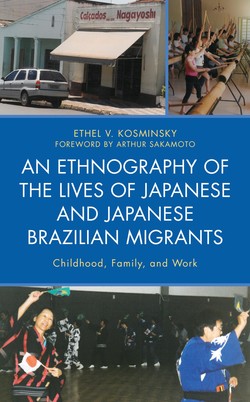Читать книгу An Ethnography of the Lives of Japanese and Japanese Brazilian Migrants - Ethel V. Kosminsky - Страница 7
На сайте Литреса книга снята с продажи.
ОглавлениеForeword
Arthur Sakamoto
It was a pleasure to read this wonderful book, and I am delighted to be able to recommend it to you. Although I have done some prior research on Japanese Brazilians, my analyses were based primarily on statistical data and published historical accounts. I did not know Ethel Kosminsky until last year when she contacted me about this ethnography that she was writing at that time. But I am very fortunate that she did because she has given me and everyone else the opportunity to read this superb book which is intrinsically informative as a detailed qualitative study as well as an important social scientific contribution to the English-language literature on Japanese Brazilians. There is much to appreciate in this book whether you are a social science scholar or a general reader interested in learning more about the drama of ethnic struggles and assimilation in a remote area of Brazil during the tumultuous era of the twentieth century.
Ethel Kosminsky’s research strategy is ambitious because it involves so many long interviews of many different persons of varying ages who had to be contacted and met face-to-face. Interviewing different generations of relatives is a painstaking process that also involves many hours of transcription and translation afterwards. This is an old-fashioned but laborious research methodology that is highly illuminating but which is becoming less commonly employed, because most sociologists these days are not as dedicated and professional as Ethel Kosminsky. The ethnography is enhanced by being interwoven and explicated with relevant social theory and sociological discussion, historical context, anthropological materials, and economic data.
For those of us who are of Japanese heritage but not Brazilian, I suspect that you find many familiar themes and stories relating to being a member of a Japanese family. You will at once recognize a kinship with individuals whom you never knew. You thereby come to a deeper understanding of your own identity and what it means to be part of the Japanese diaspora (including both positive and negative aspects).
At the same time, this familiarity is juxtaposed with a strangely different setting that evolves over time in ways that we could never have imagined. From the Brazilian jungle with homes built from mud and banana trees to a popular but fanatical political group of Japanese Brazilians who, nearly a year after the end of World War II, were murdering other Japanese Brazilians for merely acknowledging that Japan had lost that war. Reading this ethnography extending over the generations of Japanese immigrants, we feel weirdly transported into the lives of another Japanese diasporic community in a dramatically different societal context, thus coming to appreciate more fully the sociological truism that we make our own individual destinies within the contexts provided by each of our own societies.
For the Japanese audience in Japan, they too will likely feel a kindred spirit with their cousins in Brazil who, in characteristically Japanese fashion, were able to endure and persevere during difficult times. The twentieth-century history of Japan before World War II was perhaps in some ways equally harsh albeit not for undeveloped jungles and former slave owners but for the rising militarism, the repression of the people, and a series of costly wars which ended in the ultimate disaster of World War II. The latter resulted in millions of Japanese deaths and left much of Japanese society in ruins. From that vintage point of the Japanese perspective, the drama of Japanese Brazilians in their conflicted situation during World War II was certainly agonizing and harsh, but it was at least shielded from the worst ravages of that war. The happenstance advantage is then that the remote existence of the Japanese Brazilians turns out to be a blessing at least during the time when Japan was being obliterated by bombing raids.
Perhaps the greatest irony though is how the relatively recent transnational labor migration of the children and grandchildren of the initial Japanese immigrants to Brazil in some ways replicates the latter’s disappointing experiences. That is, the dream of the dekasegi Japanese Brazilians immigrating to Japan—to earn a lot of money quickly in Japan—was often thwarted. The opportunities for upward mobility were typically highly limited or blocked. Contrary to expectations, the work was often harsh and social environment uninviting. This chapter of the story informs us not only about the lives of Japanese Brazilians but also gives us valuable glimpses into the nature of contemporary Japanese society.
In sum, this book by Ethel Kosminsky is both informative and a pleasure to read. She writes with great sensitivity to the struggles and chronicles of her Brazilian compatriots. At the same time, her discussion is illuminated by social scientific analysis. In the following, you will find new stories that are intrinsically worthwhile to understand but which will also help you to place your own life experiences into a broader context.
